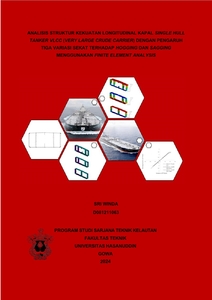Winda, Sri (2024) ANALISIS STRUKTUR KEKUATAN LONGITUDINAL KAPAL SINGLE HULL TANKER VLCC (VERY LARGE CRUDE CARRIER) DENGAN PENGARUH TIGA VARIASI SEKAT TERHADAP HOGGING DAN SAGGING MENGGUNAKAN FINITE ELEMENT ANALYSIS = Analysis of Longitudinal Strength Structure of Single Hull Tanker VLCC (Very Large Crude Carrier) with the Effect of Three Bulkhead Variations on Hogging and Sagging Using Finite Element Analysis. Skripsi thesis, Universitas Hasanuddin.
D081211063_skripsi_22-01-2025 bab 1-2.pdf
Download (1MB)
![[thumbnail of D081211063_skripsi_22-01-2025 cover1.jpg]](/43891/2.hassmallThumbnailVersion/D081211063_skripsi_22-01-2025%20cover1.jpg)

D081211063_skripsi_22-01-2025 cover1.jpg
Download (363kB) | Preview
D081211063_skripsi_22-01-2025 dp.pdf
Download (473kB)
D081211063_skripsi_22-01-2025.pdf
Restricted to Repository staff only until 21 February 2027.
Download (3MB)
Abstract (Abstrak)
Background. The objective of this study is to analyze the effect of longitudinal bulkhead configuration on the longitudinal strength of a VLCC (Very Large Crude Carrier) Tanker using a single hull. VLCC vessels require a structure that can support longitudinal strength to withstand hogging and sagging conditions. This study evaluates two bulkhead variations, namely a configuration with two symmetrical bulkheads without additional bulkheads at the center of the top and bottom and a single bulkhead configuration at the center of the ship. Methods. This study uses Non-Linear Finite Element Analysis with Ansys Mechanical APDL to determine the hull behavior of VLCC Vessels having longitudinal bulkhead configuration such as stress and deformation. The allowable stress was set at 490 N/mm² and the yield stress was 355 N/mm². Results. The study shows that the configuration of two symmetrical bulkheads produces a more even and optimal stress distribution with stress values reaching 86,92% of the allowable limit at the deck and 85,11% at the bottom when hogging, as well as 66,56% at the deck and 73,46% at the bottom when sagging. Meanwhile, the single bulkhead configuration remains adequate with stresses below the American Bureau of Shipping (ABS) clearance limits. Conclusion. The largest bending moment is achieved by the ship with two symmetrical bulkheads which is 1,45×10¹³ Nmm under hogging condition and -1,11×10¹³ Nmm under sagging condition. Thus, the configuration of two longitudinal bulkheads has greater strength than one longitudinal bulkhead.
| Item Type: | Thesis (Skripsi) |
|---|---|
| Uncontrolled Keywords: | VLCC; Cross Section; Bulkhead; Ultimate Strength |
| Subjects: | T Technology > TC Hydraulic engineering. Ocean engineering |
| Divisions (Program Studi): | Fakultas Teknik > Teknik Kelautan |
| Depositing User: | Unnamed user with username pkl2 |
| Date Deposited: | 14 Apr 2025 02:45 |
| Last Modified: | 07 May 2025 06:51 |
| URI: | http://repository.unhas.ac.id:443/id/eprint/43891 |


